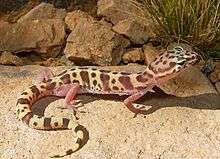Western banded gecko
The western banded gecko (Coleonyx variegatus) is a species of gecko found in the southwestern United States (southern California, southwest New Mexico, southern Arizona, Utah, Nevada) and northern Mexico (Sonora, northwest Baja California). Five subspecies are recognized.[3]
| Western banded gecko | |
|---|---|
 | |
| Scientific classification | |
| Kingdom: | Animalia |
| Phylum: | Chordata |
| Class: | Reptilia |
| Order: | Squamata |
| Family: | Eublepharidae |
| Genus: | Coleonyx |
| Species: | C. variegatus |
| Binomial name | |
| Coleonyx variegatus | |
| Synonyms[3][4] | |
Description
.jpg)
The western banded gecko is a terrestrial lizard, ranging in total length (including tail) from 4–6 inches (10–15 cm). Hatchlings measure 1 inch (2.5 cm).[5] The body is sandy-colored with dark crossbands broken into patches. The tiny scales give its skin a silky texture. Unlike typical geckos, it has prominent eyes with movable lids.[6]
Habitat
The western banded gecko is found in a wide range of habitats, including creosote bush and sagebrush desert, pinyon-juniper woodland, and catclaw-cedar-grama grass associations in the eastern part of its range and chaparral areas in the west. Its elevational range extends from below sea level to about 1,520 m (4,990 ft) asl.[1]
Behavior
The western banded gecko is secretive and nocturnal, foraging at night for small insects and spiders, and is one of the few reptiles that control scorpion populations by eating baby scorpions. If captured, C. variegatus may squeak and may discard its tail. As a defense mechanism, it can also curl its tails over its body to mimic a scorpion.[5] Females lay up to three clutches of one to two soft-shelled eggs in the spring and summer. Emerging on warm nights around 80 °F, they can be seen around porch lights looking for an easy meal, retreating if the temperature rises too high or drops too low.[7] Eggs hatch after six weeks.[5]
Niche
Predators include leaf-nosed snakes, western patch-nosed snakes, night snakes, sidewinders, western diamondback rattlesnakes, other rattlesnake species, coachwhips, and zebra-tailed lizards [8]
Additional possible predators are tarantulas, large centipedes, solpugids, coyotes and kit foxes.[8]
Subspecies
Five subspecies of Coleonyx variegatus are recognized as being valid, including the nominotypical subspecies.[3]
- Coleonyx variegatus abbotti Klauber, 1945 (San Diego banded gecko)
- Coleonyx variegatus bogerti Klauber, 1945 (Tucson banded gecko)
- Coleonyx variegatus sonoriensis Klauber, 1945 (Sonoran banded gecko)
- Coleonyx variegatus utahensis Klauber, 1945 (Utah banded gecko)
- Coleonyx variegatus variegatus (Baird, 1858) (desert banded gecko)
Nota bene: A trinomial authority in parentheses indicates that the subspecies was originally described in a genus other than Coleonyx.
Etymologies
The subspecific name, abbotti, is in honor of American ornithologist Clinton Gilbert Abbott.[9]
The subspecific name, bogerti, is in honor of American herpetologist Charles Mitchill Bogert.[9]
References
- Hammerson GA, Frost DR, Gadsden H (2007). "Coleonyx variegatus". IUCN Red List of Threatened Species. 2007: e.T64039A12739050. doi:10.2305/IUCN.UK.2007.RLTS.T64039A12739050.en.
- Baird SF (1858). "Description of New Genera and Species of North American Lizards in the Museum of the Smithsonian Institution". Proc. Acad. Nat. Sci. Philadelphia 1858: 253-256. (Stenodactylus variegatus, new species, p. 254).
- Coleonyx variegatus at the Reptarium.cz Reptile Database. Accessed 17 July 2014.
- Stejneger L, Barbour T (1917). A Check List of North American Amphibians and Reptiles. Cambridge, Massachusetts: Harvard University Press. 125 pp. (Coleonyx variegatus, p. 43).
- "Western Banded Gecko (Coleonyx variegatus)". Arizona-Sonora Desert Museum. Retrieved 2009-06-26.
- "Desert Banded Gecko - Coleonyx variegatus variegatus ". www.californiaherps.com. Retrieved 2015-08-28.
- Brennan, Thomas C. "Western Banded Gecko (Coleonyx variegatus)". Online Field Guide to the Reptiles and Amphibians of Arizona. Retrieved 2009-06-25.
- "Western Banded Gecko". digital-desert.com. Retrieved 2016-04-08.
- Beolens, Bo; Watkins, Michael; Grayson, Michael (2011). The Eponym Dictionary of Reptiles. Baltimore: Johns Hopkins University Press. xiii + 296 pp. ISBN 978-1-4214-0135-5. (Coleonyx variegatus abbotti, p. 1; C. v. bogerti, p. 30).
Further reading
- Behler JL, King FW (1979). The Audubon Society Field Guide to North American Reptiles and Amphibians. New York: Alfred A. Knopf. 743 pp. ISBN 0-394-50824-6. (Coleonyx variegatus, pp. 491–492 + Plates 392, 395).
- Goin CJ, Goin OB, Zug GR (1978). Introduction to Herpetology, Third Edition. San Francisco: W.H. Freeman. xi + 378 pp. ISBN 0-7167-0020-4. (Coleonyx variegatus, pp. 112, 129, 155).
- Smith HM, Brodie ED Jr (1982). Reptiles of North America: A Guide to Field Identification. New York: Golden Press. 240 pp. ISBN 0-307-13666-3 (paperback), ISBN 0-307-47009-1 (hardcover). (Coleonyx variegatus, pp. 66–67).
- Stebbins RC (2003). A Field Guide to Western Reptiles and Amphibians, Third Edition. Boston and New York: Houghton Mifflin. xiii + 533 pp. ISBN 978-0-395-98272-3. (Coleonyx variegatus, pp. 264–265 + Plate 24 + Map 74).
- Zim HS, Smith HM (1956). Reptiles and Amphibians: A Guide to Familiar American Species: A Golden Nature Guide. New York: Simon and Schuster. 160 pp. (Coleonyx variegatus, pp. 47, 155).
